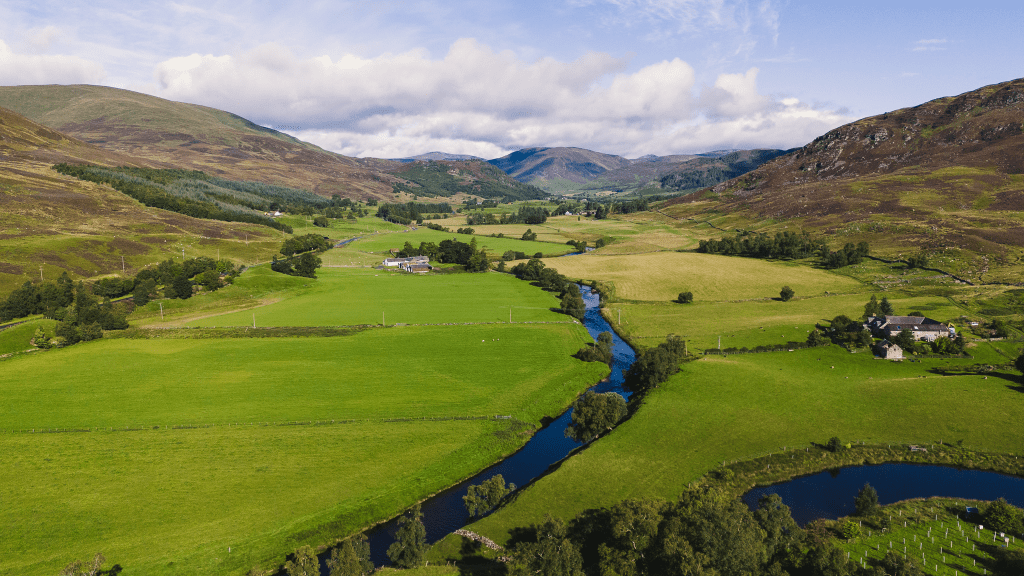River Ericht Catchment Initiative

Key Facts
43,200 ha, river catchment restoration project, delivering woodland creation and peatland restoration, with an initial focus on riparian planting.
What is the project doing for Nature and Environment?
New woodlands:
- Over 50 years, these new woodlands could sequester 9.3 million tonnes of CO2e (based on UK Woodland Carbon Code yield calculations).
- Modify local climate conditions by shading and cooling the air
- Increase biodiversity by reducing overall temperature in a river section and increase the number of colder water refuges for fish
- Helping to connect existing fragmented woodland habitats, which would help increase genetic diversity by enabling pollinator pathways and wildlife mobility
- Improve water quality by reducing nutrient run-off of phosphates, nitrates and pesticides especially in the lower reaches of the catchment where it is evidenced to be high
- Helping to stabilise riverbanks and therefore reduce soil loss through erosion and run-off
- Slowing the flow of flood events throughout the catchment
Restored peatland:
- Peatlands are the largest terrestrial carbon store, but damaged peatland is a large contributor to greenhouse gas emissions. Restoring peatland results in significant carbon avoidance
- Increase biodiversity by preserving habitats for the rare and declining species that survive in peaty areas.
- Improve water quality by slowing the flow of water through peaty areas to allow more time for nutrients such as phosphates and nitrates to be absorbed before reaching waterbodies
- Reducing flooding risks by slowing the flow of water through peatlands and increasing the habitat’s ability to hold water
Removing and/or easing active barriers to fish passage
Improving the condition of rivers will be particularly beneficial for providing salmon free access to cold clean water. We aim to work with other partners to ease and/or remove active barriers to allow fish migration. This is a priority action identified in the Scottish Government’s new Wild Salmon Strategy Implementation Plan 2023 – 2028.
This would help resolve abstraction and water quality issues that are currently caused by the disintegrating historic structures left over from the industrial revolution and the more recent landfill site.
These activities will help manage low flow issues, which in turn will allow migrating salmon free access to their spawning grounds and smolts free access downstream to the Tay and the sea.
How are communities engaged and benefiting?
- Community feed in and feed back into the project development.
- Hands-on experiential learning experiences of landscape-based activities including helping to manage non native invasive plant species.
- Keeping local people informed and generating interest in engaging with relevant activities.
- Increased knowledge locally of the challenges and opportunities of nature- based restoration and the role communities can play, including a sense of ownership in the process.
- Opportunity for community-based investment and profit sharing in nature-based solutions.
- Opportunity for local job creation and improved wellbeing.
- Not only will the delivery phase generate more green jobs, but it will encourage the application of new skills and greater agency at a local level to undertake landscape-scale nature restoration.
- We expect to see increased physical health and wellbeing as a direct result of maintained and/or improved public access to existing paths near to and alongside the riverbank as well as from new tourism and recreation opportunities.
Describe the partnerships formed and how they support project viability?
Project is being developed by consortium:
- Bioregioning Tayside
- Blairgowrie & Rattray Development Trust
- the Cateran Ecomuseum
- Mount Blair Community Development Trust
- Palladium
- Tay Ghillies Association
Current activity funded by Esmée Fairbairn Foundation.
Key Learning and Insights
The project is at preliminary stages of development, and so too early to substantial learning and insights. The project will be sharing more as the project develops, especially as a project case-study partner for the NFCA's Community Benefits Standard project and and the Riverwoods Investment Readiness Pioneers programme.
Website: https://erichtcatchment.scot
Contact: bioregioningtayside@gmail.com
